Tang dynasty art

Tang dynasty art (simplified Chinese: 唐朝艺术; traditional Chinese: 唐朝藝術; Wade–Giles: T'ang2-ch'ao2 I4-shu4; pinyin: Tángcháo Yìshù) refers to the art in China during the Tang dynasty (618-907). It is best known for the development of many forms—painting, sculpture, calligraphy, music, dance and literature.
Background
.jpg)
The Tang dynasty, with its capital at Chang'an (today's Xi'an), the most populous city in the world at the time, is regarded by historians as a high point in Chinese civilization—equal, or even superior, to the Han period. The Tang period was considered the golden age of literature and art.
Stimulated by contact with India and the Middle East, the empire saw a flowering of creativity in many fields. Buddhism, originating in what is modern day Nepal around the time of Confucius, continued to flourish during the Tang period and was adopted by the imperial family, becoming thoroughly sinicized and a permanent part of Chinese traditional culture. Block printing made the written word available to vastly greater audiences.
Painting


Beginning in the Tang dynasty, the primary subject matter of Chinese painting was the landscape, known as shanshui (mountain-water) painting. In these landscapes, usually monochromatic and sparse, the purpose was not to reproduce exactly the appearance of nature but rather to grasp an emotion or atmosphere so as to catch the "rhythm" of nature.
Trading along the Silk Road of various products increased cultural diversity in cosmopolitan Chinese cities, such as Chang'an, had a marked influence on the Chinese arts of the Tang dynasty. Many designs that were enjoyed with the upper classes of imperial China became common even in everyday art.[1]
Music
The first major well-documented flowering of Chinese music was for the qin during the Tang dynasty, though the qin is known to have been played since before the Han dynasty.
Late 20th century excavations of an intact tomb of the period revealed not only a number of instruments (including a spectacular concert bell set) but also inscribed tablets with playing instructions and musical scores for ensemble concerts, which are now heard again as played on reproduction instruments at the Hubei Provincial Museum.
Opera
Chinese opera is generally dated back to the Tang dynasty with Emperor Xuanzong (712-755), who founded the Pear Garden, the first known opera troupe in China. The troupe mostly performed for the emperors' personal pleasure.
Poetry
The Poetry of the Tang dynasty is about the most appreciated poetic era of Chinese poetry. The shi, the classical form of poetry which had developed in the late Han dynasty, reached its zenith.
During the Tang dynasty, poetry became popular. It was a sign of learning. Many people wrote poems. One of China's greatest poets was Li Po, who wrote about ordinary people and about nature. Nature was a powerful force in Chinese art. One of Li Po's short poems was titled "Waterfall at Lu-Shan". It shows how Li Po felt about nature.
Tang dynasty artists
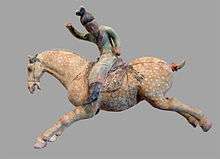
- Bai Juyi (772-846), poet
- Zhou Fang (730-800), painter, also known as Zhou Jing Xuan and Zhong Lang
- Cui Hao, poet
- Han Gan (718-780), painter
- Zhang Xuan (713-755), painter
- Du Fu (712-770), poet
- Li Bai (701-762), poet
- Meng Haoran (689 or 691-740), poet
- Wang Wei (699-759), poet, musician, painter
- Wu Tao-Tzu (680-740), famous for the myth of entering an art work
- Zhang Jiuling (678-740), poet
Gallery
-

A rounded ceramic plate with "three colors" glaze and floral design, 8th to 9th century.
-
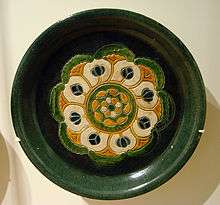
A rounded ceramic plate with "three colors" glaze, 8th century.
-
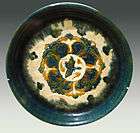
A ceramic offering plate with "three colors" glaze, decorated with a bird and trees, 8th century.
-
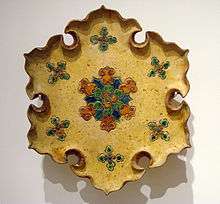
A ceramic offering plate with six eaves and "three colors" glaze, 8th century.
-
A gilded bronze Avalokitesvara statuette, late 7th or early 8th century
-

Three of eight terracotta lady musicians on horseback, early 8th century
-

Early T'ang period palace maids, Shensi History Museum
-

Tang court ladies, 706 AD, Qianling Mausoleum
-
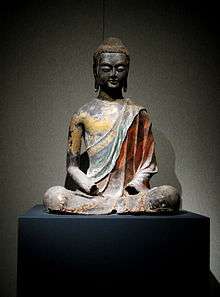
Seated Mahayana Buddha statue
-
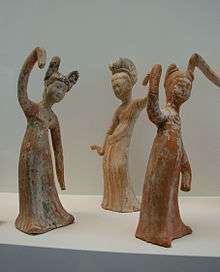
Ladies dancing, 7th century
-

A figurine of a plump Tang woman
-

Earthenware statue of a foreigner with a wineskin, c. 674–750
-
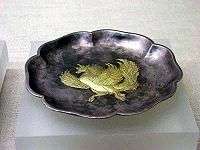
Gilt hexagonal silver plate with a Fei Lian beast pattern
-

A Tang portrait of Emperor Wen of Sui, by Yan Liben, 7th century
-

Buddhist mural in the Bezeklik grottoes, 9th century
-

”Tejaprabhā Buddha and the Five Planets”, 897 A.D., British Museum
-
Tang dynasty bodhisattva statue missing its head and left arm
-
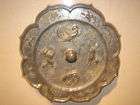
A Tang dynasty bronze foliate mirror
-
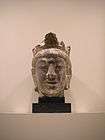
Statue head of Guanyin
-

A limestone statue of a mourning attendant, 7th century
-

Terracotta lady, 7th-8th century
-

”Lokhapala on a Recumbent Bull”, 618-906, Brooklyn Museum
-
Tang clay figurine of a Sogdian man wearing a distinctive cap and face veil, possibly a camel rider or even a Zoroastrian priest engaging in a ritual at a fire temple, 8th century AD
See also
| Wikimedia Commons has media related to Art of the Tang dynasty. |
References
- ↑ Birmingham Museum of Art (2010). Birmingham Museum of Art : guide to the collection. [Birmingham, Ala]: Birmingham Museum of Art. p. 24. ISBN 978-1-904832-77-5.
Further reading
- Watt, James C.Y.; et al. (2004). China: dawn of a golden age, 200-750 AD. New York: The Metropolitan Museum of Art. ISBN 1588391264.

